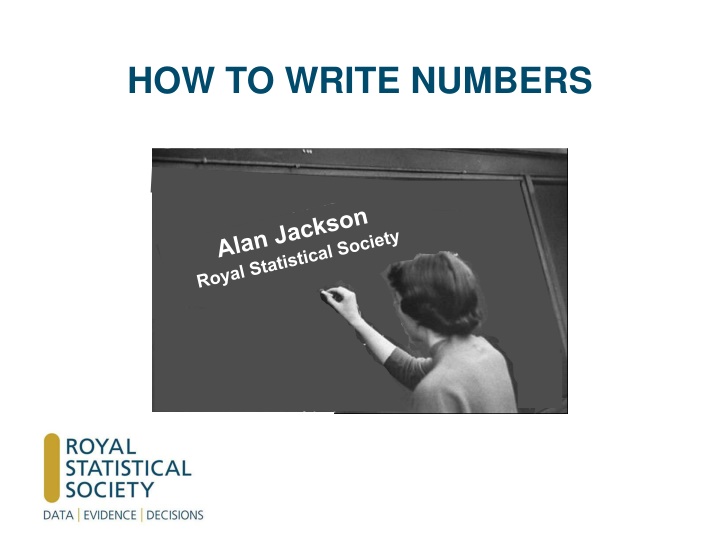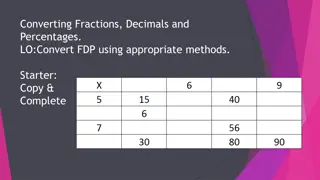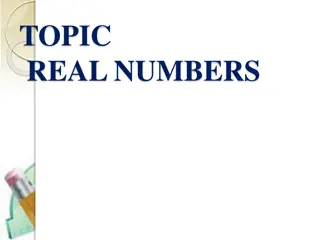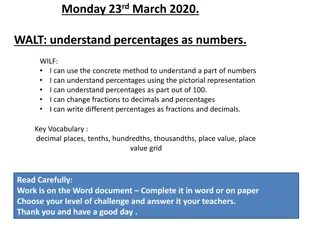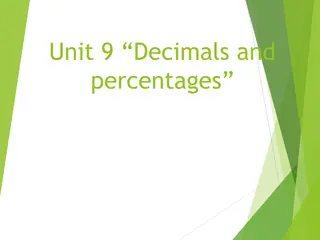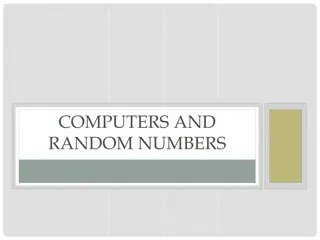Effective Strategies for Writing Numbers and Summarizing Percentages
Discover helpful techniques for writing numbers correctly, including grammar usage and choosing between words or figures. Learn about a system for summarizing percentages, making data easier to read and recall. Explore examples where precise percentages are crucial and how different summary formats are used. Gain insights into presenting statistical data in a clear and concise manner.
Download Presentation

Please find below an Image/Link to download the presentation.
The content on the website is provided AS IS for your information and personal use only. It may not be sold, licensed, or shared on other websites without obtaining consent from the author.If you encounter any issues during the download, it is possible that the publisher has removed the file from their server.
You are allowed to download the files provided on this website for personal or commercial use, subject to the condition that they are used lawfully. All files are the property of their respective owners.
The content on the website is provided AS IS for your information and personal use only. It may not be sold, licensed, or shared on other websites without obtaining consent from the author.
E N D
Presentation Transcript
How to Write Numbers Part II: System for summarising percentages
How to Write Numbers Three parts: grammar and the correct use of words, system for summarising percentages, the use of words or figures when writing numbers.
How to Write Numbers This part is on: grammar and the correct use of words, system for summarising percentages, the use of words or figures when writing numbers.
Summarising Percentages summarising percentages sometimes a precise percentage is needed, like 65.9 per cent sometimes 2 out of 3 is accurate enough and is generally easier to read and recall
Summarising Percentages The next slide gives a series of precise percentages. The slide following it summarises the same information, which makes it a bit easier to read.
Summarising Percentages Before the number of cannons were limited, 19.8 per cent of billiard players were regularly making century breaks, but after the rules changed this fell to 4.9 per cent. Nearly 68.3 per cent of players own their own cue and 48.6 per cent of them play in a local league.
Summarising Percentages Before the number of cannons were limited, 1 in 5 billiard players were regularly making century breaks, but after the rules changed this fell to 1 in 20. Nearly two-thirds of players own their own cue and half of them play in a local league.
Summarising Percentages summarising percentages three kinds of summary have been used 1 in N because it s easy enough to compare 1 in 4 with 1 in 9 N in 10 because it s easy enough to compare 3 in 10 with 7 in 10 N-1 in N because it s not too difficult to compare 2 out of 3 with 19 out of 20
Summarising Percentages summarising percentages mixing other formats could make the proportions hard to compare which is bigger 4 in 7 or 5 in 9 ? 3 in 5 or 7 in 12 ? what about
Summarising Percentages summarising percentages Incidentally, the exception is a set of two or more summaries, together in a group (which are not compared with another group), which are of the form x in N, y in N, z in N, For example; 1 in 7 2 in 7 4 in 7 2 in 12 1 in 6 2 in 12 3 in 12 1 in 4 3 in 12 8 in 12 2 in 3 8 in 12 9 in 12 3 in 4 9 in 12
Summarising Percentages The attached PDF document gives a table for summarising percentages: this is part of it. percentage 1.0% summary 1 in 100 1.1% 1 in 90 ... 68.4% two-thirds 71.7% 7 out of 10 ...
Summarising Percentages summarising percentages to find a percentage summary look for the smallest percentage (in the percentage column) which is greater than or equal to the percentage you want to summarise use the summary next to it
Summarising Percentages summarising percentages to find a summary of 18.9% 15.3% 1 in 7 18.1% 1 in 6 18.9% 19.2% 18.9% is nearly 1 in 5 or a fifth 21.7% 1 in 5 or a fifth
